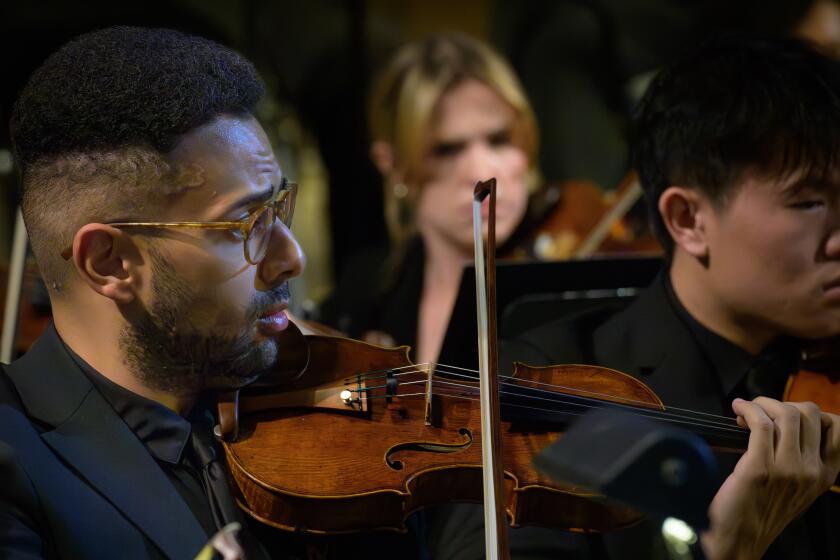Sex vs. Race: A Tough Call for Esquire
Editor-in-chief Lee Eisenberg had to choose between sex and race for the May cover of Esquire.
He opted for sex. In the magazine equivalent of a neon sign, the word is emblazoned in tall purple type across a woman’s bare midriff, announcing a 19-page package on the relationship between pleasure and health.
But Eisenberg says the decision wasn’t as easy as it might seem. He made his choice because he couldn’t figure out a way to illustrate the issue’s major and potentially most controversial story--a long article by Taylor Branch on the enmity between blacks and Jews--”without in some fundamental way sensationalizing what he wrote.”
Even so, Eisenberg had doubts about whether it was safe to use that three-letter word on the cover. “I was not at all sure putting sex on the cover in 1989 was a good idea,” he said in a telephone interview.
Departure From the Usual Approach
Nonetheless, Eisenberg made it clear that he considers Branch’s article the keystone of the issue and something of a departure from the magazine’s usual approach. Among other things, the story is about 40% longer than Esquire’s typical lead story, he said, explaining that the length reflects the complexity of the subject and the magazine’s desire to give it proper treatment.
Branch--author of “Parting the Waters,” the best seller about the civil rights movement--spent three months researching and writing the piece of “journalistic history” about the evolution of tensions between the two groups. “The Uncivil War” centers on the history of race relations in Chicago but it spreads a wide net. Branch covers Scripture, writes about the rise of ghettos in prerevolutionary Russia and Chicago, as well as doing quick sketches of the city’s black leaders, including the Rev. Jesse Jackson.
Controversy, Confrontation
As noted by Branch, a controversy last year involving anti-Semitic statements by Steve Cokely, “a minor aide to acting (Chicago) Mayor Eugene Sawyer,” soon was “spilling into other regions of the country.” Branch writes that the crisis stemming from Cokely’s behavior “brought widespread acknowledgement of a fundamental rupture in the old civil rights coalition.”
Branch describes the confrontation this way: “Two minorities of longstanding mutual empathy have suddenly become both the victims and the perpetrators of racial hatred. . . . Two sources of votes for the Democratic Party, and moral guidance for both parties, appear to have split apart. More ominously, these spasms of enmity affect two of the most volatile areas in contemporary politics--the Middle East, which remains a most likely spot for the world’s next major war, and the black inner cities of the United States, which already seethe with signs of social breakdown.”
In his concluding passage, Branch observes that “American public life is accustomed to the faces and words of tormented black prophets, but none of them dares to tell their people that they may have to become more like Jews--rising from the rubble family by family, shop by shop. . . . Against this surfeit of black prophets, Jews have no commanding voices . . . there is no pre-eminent leader who summons Israel to do justice by the Palestinians in the name of Amos and Isaiah. In many respects, blacks and Jews need an exchange rather than a war of leadership, but their steep paths are littered with pride.”
Editor Eisenberg said that early reaction to the article has been favorable but that he “would very much hope the piece sparks some intelligent debate.” A magazine spokesman said that two readers had been chagrined enough by Branch’s effort to call the magazine in protest.
Peace Prevails
The Western Publications Assn.’s 1989 Publishing Conference here Thursday and today seems likely to be as peaceful as usual. That’s thanks to an agreement worked out early this week between the association and writers in a dispute over a magazine entered in the group’s awards contest for trade and consumer magazines, the Maggies.
Under the agreement, contest entrant Monterey Life won’t receive any awards it may win until a legal dispute between the magazine and its contributing writers is settled, said conference chairman Peter M. Craig. Meanwhile, writers disgruntled with the magazine will not carry out threats to picket the convention, spokesman Ray March said.
Since early this year, writers pulled together by the Santa Cruz-Monterey chapter of the National Writers Union have been battling the publisher of Monterey Life over an anthology issue, “The Best of Monterey Life,” published last January. Writers charged that the magazine had no right under copyright law to reprint their work from previous years without permission of the authors, said March, co-chairman of the union local.
Writers Filed Suit
March said writers were so incensed by the collection of reprints that they filed a class-action suit and won a preliminary injunction from U.S. District Judge Robert P. Aguilar. The judge ordered Monterey Life to cease distribution of the anthology and to recall all copies.
Craig said that agreement reflects the association’s position that it “cannot make a judgment to whether they (Monterey Life) are guilty.” At the awards ceremony today, Monterey Life would be announced as a winner but it would not be presented with the trophy, Craig said.
Publishers of Monterey Life could not be reached for comment.
With that contretemps out of the way, publishers, editors and writers attending the conference will be able to go about the business of attending seminars uninterrupted. Topics include “Legal Considerations in Publishing” and “For Writers: How to Get Along With Editors.”
It’s still possible to attend the conference by registering at the door. The conference is at the Los Angeles Airport Hilton. Writer George Plimpton is the guest speaker at a 6:15 reception tonight.
An Easier Ride
Two decades after the characters Capt. America and Billy started their doomed voyage across America in the 1969 movie “Easy Rider,” writers Jack Barth and Trey Ellis--on assignment for Premiere magazine--apparently had a pretty good time retracing the motorcycle tracks of that episodic ride into ultimate darkness.
But, boy, have times changed.
For their 20th anniversary celebration of the movie in the May issue, the two drove a Cadillac instead of riding Harley-Davidsons. And--according to their account--Barth and Ellis didn’t do a drug deal to finance their trip, didn’t stop at communes, didn’t go on an LSD trip--and they didn’t get killed.
Children of the ‘80s
Obviously, verisimilitude was not an object.
The pair--decidedly children of the 1980s, not the 1960s--trekked to such landmarks as Valentine, Ariz., and Morganza, La., in their playful re-creation of the movie’s largely ad-libbed script. Along the way, they found a few of the locals drafted for roles in the movie. One man still remembers that actor Dennis Hopper, who played Billy, had never mailed him--as promised--the leather jacket he wore in the movie. A woman in Louisiana, who played a teen-ager in the movie, had an anti-drug message for “Easy Rider’s” other star.
“You can tell Peter Fonda I’m happy sitting here drinking Coke,” 37-year-old LeBlanc Moore told Barth and Ellis. “It’s better than the other kind.”
More to Read
The biggest entertainment stories
Get our big stories about Hollywood, film, television, music, arts, culture and more right in your inbox as soon as they publish.
You may occasionally receive promotional content from the Los Angeles Times.






